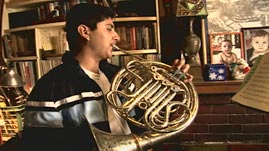Teachers' Domain - Digital Media for the Classroom and Professional Development
User: Preview


Source: From the Top at Carnegie Hall: "From C to Shining Sea"
You can see the full episode and a more complete lesson plan at the From the Top at Carnegie Hall Web site.



Exclusive corporate funding provided by Liberty Mutual. Additional funding provided by the Bernard Osher Foundation, the Jack Kent Cooke Foundation, the National Endowment for the Arts, Helen and Peter Bing, and the E.H.A. Foundation.
In this video segment from From the Top at Carnegie Hall, Eliodoro Vallecillo, a talented young musician who plays in several genres, talks about how playing the French horn helped him grieve the death of his older brother. He describes how, with the support of his family, he went to live with his music teacher so that he could attend a school that offered a good music education. Watch Eliodoro also performing the Norteño music of his Mexican-American culture for fun with friends.
The French horn (now known simply as "the horn") evolved from the hunting horns of medieval Europe, which were long coiled tubes of a metal such as brass with a mouthpiece on one end and a bell (broad opening) on the other. The horns of Mozart's day were "natural" horns, without any valves to vary the length of the brass tubing and thereby the pitch of the notes. Skilled horn players of the 18th century could achieve remarkable results by varying the way they blew into the instrument (the embouchure) and by inserting one hand into the bell of the horn to shorten the length of the air column. (Embouchure refers to the way the lips, mouth, tongue, and other facial structures are used to blow air into a wind instrument. By varying the embouchure, a musician can produce different pitches and tones on an instrument.) The 18th century horn player could also use a crook (a piece of brass tubing) inserted into the instrument to change its pitch, although this method was not suited to rapid changes! By contrast, the modern slide trombone is an instrument whose pitch can be varied almost instantly by changing the length of the tube in which the air travels.
Modern horns, which are members of the brass family, have about 12 feet of tubing and four valves that can be depressed in various combinations to change the pitch of the note being played. The range of the instrument is about four octaves. Playing a valved horn is much easier than playing the natural horn, although it still demands great technical skill to play virtuoso pieces like the Mozart piece performed by Eliodoro Vallecillo in the video segment. Mozart wrote four horn concertos, several of them for a friend and accomplished player called Joseph (Ignaz) Leutgeb (or Leitgeb). Mozart was aware of the technical difficulties his compositions presented and made several joking references to this fact in his notes to the scores. Today these horn concertos are a fundamental component of the horn repertoire.
Eliodoro Vallecillo is a talented young musician from California who found music to be a great source of comfort and inspiration after the death of his older brother. In addition to playing classical music, Eliodoro is interested in other genres, including the Norteño music of his Mexican-American culture.
To hear Eliodoro play on From the Top's radio program, and to read his powerful story in his own words, check out From the Top
National Music Standards: Content Standard 9: Understanding music in relation to history and culture
 Loading Standards
Loading Standards